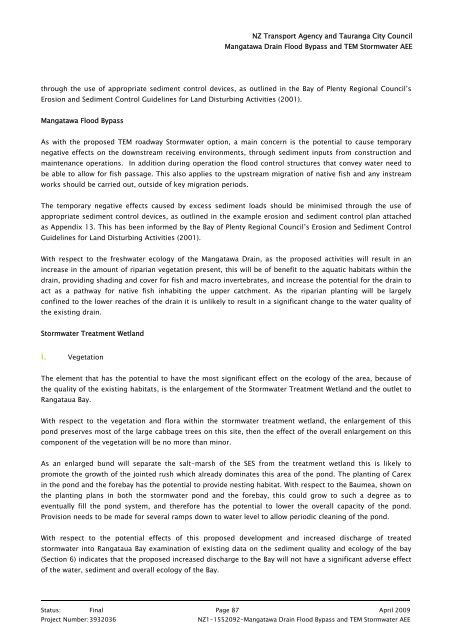2. Mangatawa catchment consents for earthworks, storm water ...
2. Mangatawa catchment consents for earthworks, storm water ...
2. Mangatawa catchment consents for earthworks, storm water ...
- No tags were found...
Create successful ePaper yourself
Turn your PDF publications into a flip-book with our unique Google optimized e-Paper software.
NZ Transport Agency and Tauranga City Council<br />
<strong>Mangatawa</strong> Drain Flood Bypass and TEM Storm<strong>water</strong> AEE<br />
through the use of appropriate sediment control devices, as outlined in the Bay of Plenty Regional Council’s<br />
Erosion and Sediment Control Guidelines <strong>for</strong> Land Disturbing Activities (2001).<br />
<strong>Mangatawa</strong> Flood Bypass<br />
As with the proposed TEM roadway Storm<strong>water</strong> option, a main concern is the potential to cause temporary<br />
negative effects on the downstream receiving environments, through sediment inputs from construction and<br />
maintenance operations. In addition during operation the flood control structures that convey <strong>water</strong> need to<br />
be able to allow <strong>for</strong> fish passage. This also applies to the upstream migration of native fish and any instream<br />
works should be carried out, outside of key migration periods.<br />
The temporary negative effects caused by excess sediment loads should be minimised through the use of<br />
appropriate sediment control devices, as outlined in the example erosion and sediment control plan attached<br />
as Appendix 13. This has been in<strong>for</strong>med by the Bay of Plenty Regional Council’s Erosion and Sediment Control<br />
Guidelines <strong>for</strong> Land Disturbing Activities (2001).<br />
With respect to the fresh<strong>water</strong> ecology of the <strong>Mangatawa</strong> Drain, as the proposed activities will result in an<br />
increase in the amount of riparian vegetation present, this will be of benefit to the aquatic habitats within the<br />
drain, providing shading and cover <strong>for</strong> fish and macro invertebrates, and increase the potential <strong>for</strong> the drain to<br />
act as a pathway <strong>for</strong> native fish inhabiting the upper <strong>catchment</strong>. As the riparian planting will be largely<br />
confined to the lower reaches of the drain it is unlikely to result in a significant change to the <strong>water</strong> quality of<br />
the existing drain.<br />
Storm<strong>water</strong> Treatment Wetland<br />
i. Vegetation<br />
The element that has the potential to have the most significant effect on the ecology of the area, because of<br />
the quality of the existing habitats, is the enlargement of the Storm<strong>water</strong> Treatment Wetland and the outlet to<br />
Rangataua Bay.<br />
With respect to the vegetation and flora within the <strong>storm</strong><strong>water</strong> treatment wetland, the enlargement of this<br />
pond preserves most of the large cabbage trees on this site, then the effect of the overall enlargement on this<br />
component of the vegetation will be no more than minor.<br />
As an enlarged bund will separate the salt-marsh of the SES from the treatment wetland this is likely to<br />
promote the growth of the jointed rush which already dominates this area of the pond. The planting of Carex<br />
in the pond and the <strong>for</strong>ebay has the potential to provide nesting habitat. With respect to the Baumea, shown on<br />
the planting plans in both the <strong>storm</strong><strong>water</strong> pond and the <strong>for</strong>ebay, this could grow to such a degree as to<br />
eventually fill the pond system, and there<strong>for</strong>e has the potential to lower the overall capacity of the pond.<br />
Provision needs to be made <strong>for</strong> several ramps down to <strong>water</strong> level to allow periodic cleaning of the pond.<br />
With respect to the potential effects of this proposed development and increased discharge of treated<br />
<strong>storm</strong><strong>water</strong> into Rangataua Bay examination of existing data on the sediment quality and ecology of the bay<br />
(Section 6) indicates that the proposed increased discharge to the Bay will not have a significant adverse effect<br />
of the <strong>water</strong>, sediment and overall ecology of the Bay.<br />
Status: Final Page 87 April 2009<br />
Project Number: 3932036<br />
NZ1-1552092-<strong>Mangatawa</strong> Drain Flood Bypass and TEM Storm<strong>water</strong> AEE
















